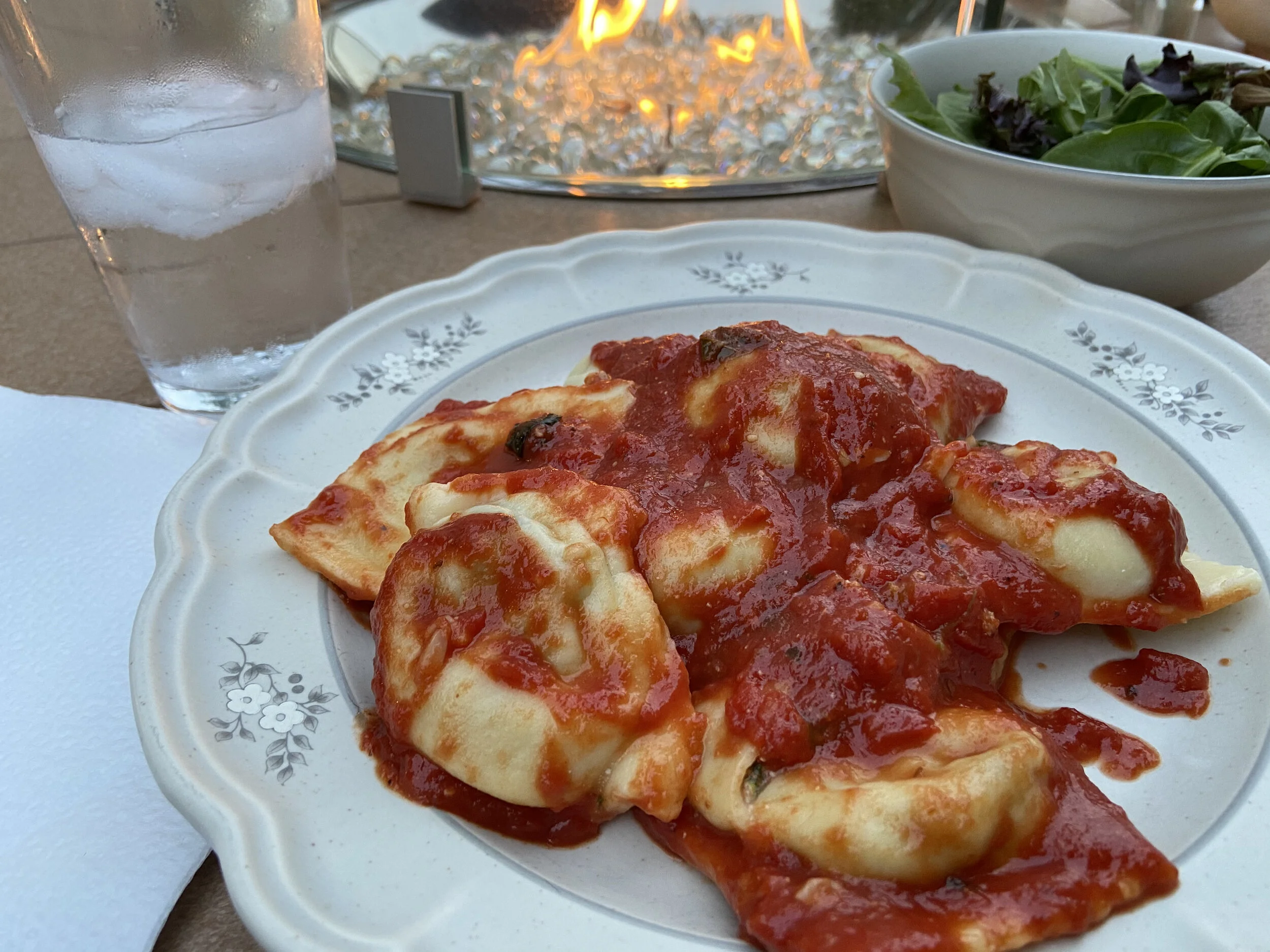Red, white, and green completed. Wonderful sauces that will really give you something to show off to friends and family. What's that you say? You want marinara sauce? Really? It's so basic...
In all seriousness, marinara sauce is a vital page in someone's culinary repertoire. It is a fundamental building block of virtually every Italian-American dish. And readers of this blog know that simplicity is next to Godliness. So if we're to move forward, you need to know how get on this level of Red-Sauce action:
See how it coats the ravioli? Now, that's a beautiful thing.
Any paisan can tell you that tomatoes are a vital element of Southern Italian cuisine. Given the fact that the vast majority of Italian immigrants to the United States came from regions of the South, especially Naples and Sicily, Americans automatically associate Italian food with tomatoes. I bet you do too, right?
But things were not always so saucy. Fourteen ninety-two was a critical date, beyond the rhyme about a certain Italian crossing a certain body of water to discover a certain landmass. Yes, beyond the confused voyage of Cristobal Colombo of Genoa, 1492 also represents the start of what is referred to as the Columbian Exchange. This gigantic trans-continental movement of goods, people, and diseases totally altered the trajectory of human history. Sugar, horses, and smallpox went Westward; in return, Europeans received turkey, chiles, potatoes, syphillis, and of course, tomatoes.
So, that means prior to the late 15th century, and more realistically the mid-to-late 16th century, tomatoes were no where near Italy. So for most of human history, TOMATOES =/= ITALY!
So how the hell did tomatoes become such an integral part of Italian cuisine? Well, one can look at the name of this sauce to get a sense of the trajectory. "Marinara" means "Mariner's" or "Sea-related." Italian traders in the South, which was at that point was part of the Spanish Empire, evidently had easy access to the new products coming over from Imperial activities in Mesoamerica. Tomatoes were part of that package. Not only were these fruits exotic (and tasty), but they also grow very well in warm, sunny climates such as...well...Southern Italy. So essentially, it was kismit from the start. Tomatoes became an integral part of cuisine in Southern Italy. When many left Italy for the United States in the early-twentieth-century, Red-Sauce Italian--the stuff Tony and Carmela Soprano are constantly talking about--was born.
And that makes perfect sense. Unlike some of the more involved dishes, Marinara is quite easy to execute: it takes very little time, and only a few ingredients.
Marinara Sauce
1 bottle passata or 28-oz can of whole peeled tomatoes
2 tablespoons olive oil
3 cloves garlic
1/2 tablespoon oregano
1/4 tablespoon red chili flakes
1.5 oz basil
2 tablespoons Parmesan cheese
Salt and pepper
Splash of white wine (optional)
First, drizzle about three tablespoons of good olive oil into a pan and plop four or so cloves of minced garlic in there. Turn the heat up to medium, and cook the garlic until its fragrant. DO NOT BURN THE GARLIC. It will get bitter--acrid, even--and will lose that sulfurous-ness we all know and love. If you burn it, start over. I'm serious, it just won't be good. You burned it, didn't you? Start over.
Now, put at least a teaspoon of chili flake and a tablespoon of oregano in the oil and let them (GENTLY) toast a little bit, stirring well, about 20 seconds. In addition to the essential oils of the chili and oregano, which are obviously fat-soluble, the capsaicin in the chili flake, the compound responsible for burning our mouths and lips when eating chicken wings, is also fat soluble. We want to make sure that our oil is uniformly infused with goodness, otherwise the sauce will have weird pockets of flavor. We want a sonorous symphony. Not some any dubstep crap.
Now jack the heat up and quickly pour in your bottle of passata in this case. Today, I prefered passata to crushed tomatoes, because it renders a smoother sauce. But you can feel free to choose whatever tomato iteration you'd like. Like it thick, like for eggplant parmesan or spaghetti and meatballs? Use a can of whole, peeled tomatoes. Just use your hands to break up the tomatoes well before dumping them into the oil. And simmer a little bit longer to tighten the sauce up into a lovely, cohesive mix that'll adhere to pasta.
Finally, basil. Put a lot of leaves in there. Just tear 'em up with your hands and throw them in there. Dribble in a splash of white wine, if you're using it. Let the whole thing reduce for about 20 minutes. Test it for salt and pepper. Then hit it with a lot of quality Parmesan cheese. None of that sawdust. Salt and pepper to taste. And that's all she wrote.
There you have the basic marinara sauce. It's that easy. But it is extraordinarily powerful. Over the couple of posts thus far, I hope you've gotten a sense that Italian is a fairly modular cuisine. That is, there are certain building blocks, in terms of techniques, raw materials, and finished products, that you can combine and recombine to create unique dishes. Marinara sauce is perhaps the most versatile of the Italian sauces. You can mix and match and never get bored. You just need a little creativity. So here's your homework: see if you can make dinner tonight that has marinara sauce as an ingredient. The other ingredients are up to you. No searching for recipes, now. Just use your stomach and brain as guides. Be as daring as an Italian sailor seeing tomatoes for the first time.





